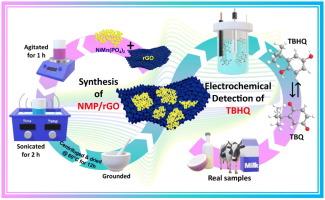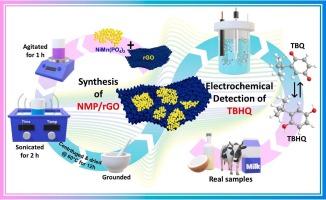用于致癌抗氧化剂检测的创新电化学传感器设计:修饰在还原氧化石墨烯纳米片上的双金属磷酸盐纳米颗粒
IF 9.8
1区 农林科学
Q1 CHEMISTRY, APPLIED
引用次数: 0
摘要
合成抗氧化剂在防止氧化降解和延长产品保质期方面发挥着至关重要的作用。然而,由于潜在的健康风险和环境影响,它们的广泛使用引起了人们的关注。其中,叔丁基对苯二酚(TBHQ)被广泛使用,但过量食用会造成毒性和过敏风险。准确、灵敏地检测四溴六酚对于确保安全和符合法规至关重要。在这项研究中,我们开发了一种用于TBHQ检测的先进电化学传感器,利用双金属磷酸盐纳米颗粒(NiMn(PO4)2)与还原氧化石墨烯(rGO)集成的纳米复合材料。利用场发射扫描电镜、高分辨率透射电镜、能量色散x射线光谱、傅里叶变换红外光谱、拉曼光谱和x射线衍射等技术对该材料进行了表征,证实了该复合材料的结构完整性和成分协同性。电化学分析,如电化学阻抗谱和循环伏安法,证明了传感器的优异性能,其特点是低电荷转移电阻(61 Ω)和增强的峰值电流响应。这些改进归功于NMP丰富的活性位点和氧化石墨烯优越的电子转移能力。该传感器具有良好的分析能力,线性检测范围为0.01 ~ 340 μM,超低检出限为0.006 μM。该传感器在牛奶和椰子油等实际食品样品中成功检测了三溴六酚,回收率为96.6% % ~ 99.2% %,确保了可靠性和准确性。这些结果证明了NMP/rGO复合材料作为一种高效可靠的电化学平台监测食品中合成抗氧化剂的潜力。本文章由计算机程序翻译,如有差异,请以英文原文为准。


Innovative electrochemical sensor design for carcinogenic antioxidant detection: Bimetallic phosphate nanoparticles decorated on reduced graphene oxide nanosheets
Synthetic antioxidants play a vital role in various industries by preventing oxidative degradation and extending product shelf life. However, their extensive use raises concerns due to potential health risks and environmental impact. Among these, tert-butylhydroquinone (TBHQ) is widely used but can pose toxicity and allergenic risks when consumed in excess. Accurate and sensitive detection of TBHQ is crucial for ensuring safety and regulatory compliance. In this study, we developed an advanced electrochemical sensor for TBHQ detection, utilizing a nanocomposite of bimetallic phosphate nanoparticles (NiMn(PO4)2) integrated with reduced graphene oxide (rGO). The material was characterized using various techniques, including field emission scanning electron microscopy, high-resolution transmission electron microscopy, energy-dispersive X-ray spectroscopy, Fourier-transform infrared spectroscopy, Raman spectroscopy, and X-ray diffraction, which confirmed the structural integrity and compositional synergy of the composite. Electrochemical analyses, such as electrochemical impedance spectroscopy and cyclic voltammetry, demonstrated the sensor's excellent performance, characterized by low charge transfer resistance (61 Ω) and an enhanced peak current response. These improvements were attributed to the abundant active sites of the NMP and the superior electron transfer capabilities of rGO. The sensor exhibited remarkable analytical capabilities, with a wide linear detection range from 0.01 to 340 μM and an ultra-low detection limit of 0.006 μM. The practical applicability of the sensor was confirmed through its successful detection of TBHQ in real food samples, including cow milk and coconut oil, with recovery rates ranging from 96.6 % to 99.2 %, ensuring both reliability and accuracy. These results demonstrate the potential of the NMP/rGO composite as a highly efficient and reliable electrochemical platform for monitoring synthetic antioxidants in food products.
求助全文
通过发布文献求助,成功后即可免费获取论文全文。
去求助
来源期刊

Food Chemistry
工程技术-食品科技
CiteScore
16.30
自引率
10.20%
发文量
3130
审稿时长
122 days
期刊介绍:
Food Chemistry publishes original research papers dealing with the advancement of the chemistry and biochemistry of foods or the analytical methods/ approach used. All papers should focus on the novelty of the research carried out.
 求助内容:
求助内容: 应助结果提醒方式:
应助结果提醒方式:


